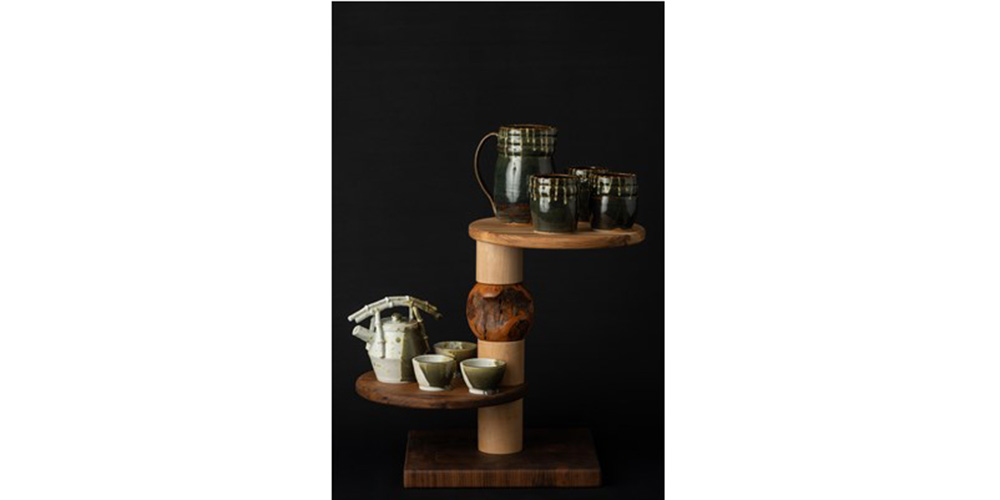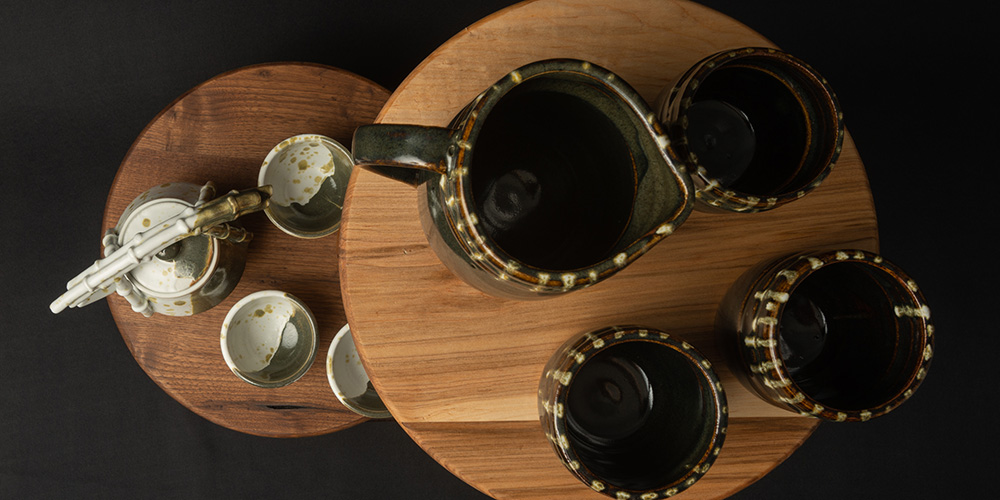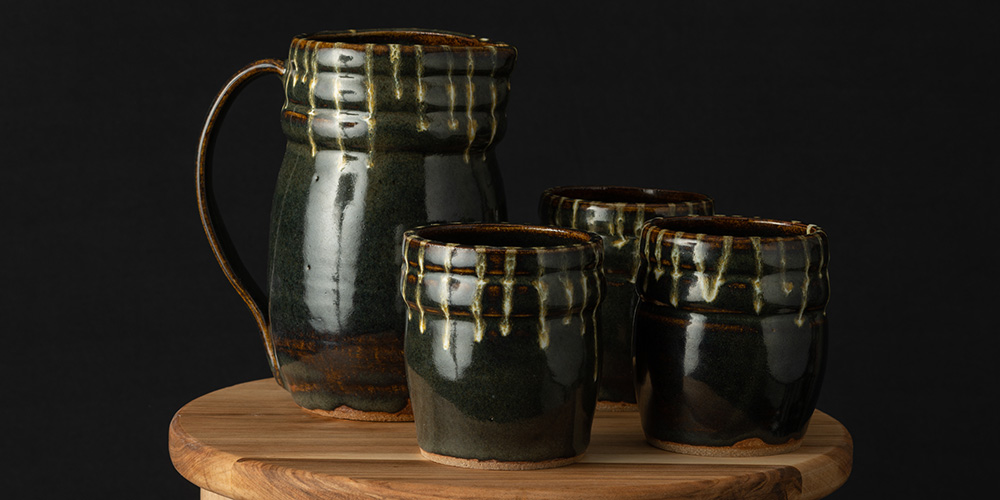Annual Invest Nest High School Business Plan Competition to Select Winners at Public Event
April 26th, 2024
Our city is proud to host the Invest Nest state competition, and we wish Kara Miller from our...

Robert Davison believes that your life experiences should inform your craft—everything in service in perfecting your chosen passion. Hard work and continuous incremental learning act as pillars for his teaching philosophy.
Enter his star student, Milla Alexandra Prokhorov. Milla was born on the upper-east side of New York but moved a lot throughout her childhood. Milla spent most of her life in Moscow, Russia, before moving to California and eventually ending up here in Utah for the last four years. Milla’s life as a Russian-American with travel experience is integral to her interest in ceramics and her piece’s design.
Milla’s first hands-on experience with ceramics came in a remote, satellite town outside Moscow. As a youth, her class visited the town’s small pottery studio, where she threw pottery for the first time. The experience sat with her for years. She then traveled to New York where she regularly visited the Ceramics exhibit in the Metropolitan Museum of Art. Her thoughts revolved around pottery; Milla was locked in an orbit that would inevitably draw her to the Intro to Ceramics class at Timpview.
“The rest is history. I’ve since been infatuated with pottery. When I started, I spent every waking moment thinking about or working on pottery. I spent five to six hours a day at the wheel, centering, throwing.
“I was not a natural. It took time, but eventually, I felt prepared to help teach. I was always told by Mr. Davison that teaching was the path to mastery. Teaching helped me hone my knowledge and ability within the craft, and I then felt comfortable enough to develop my own art.” Davison recalls how Milla would walk the halls coated in clay, marking her as a ceramic artist.
“The sense of accomplishment was gradual for me,” Milla admits. “Every piece, I learned something new. Failing– well, I’m sort of a perfectionist, and the wheel form process incorporates centripetal force– theoretically, you can always make the form more perfectly centered– so failing was challenging but rewarding. I like the idea that you can chase perfection. Eventually, my pieces varied in width and height, growing taller, more complex.”
Milla notes that ninety percent of her work ended up recycled. Milla said that she had a hard time admitting that she was an artist, before Davison interjected. “It’s the mark of a true artist. You are your worst critic, but you’ve produced incredible art. So– the rule this year is that she doesn’t throw any art out.”
The continued theme of perfection through a thousand attempts marks Milla’s piece, Where the Eastern Moon Meets the Western Sun. “I started this piece last August and didn’t finish until a few days before the deadline,” Milla said. “The art can’t be an exact representation, but I poured my heart and soul into this to express my ability as an artist and who I am. I’ve had this idea brewing for two years. The completed version is my ninth attempt at this piece. There were times when I wanted to quit; it was seriously tough.”




Here is Milla’s Artist’s Abstract on the piece:
In this piece, I investigated ways to interweave Americana and Asian styles of pottery displayed in a way that portrays a lunar eclipse. The Asian set was designed in a contemporary geometric fashion, and the handle imitates the stalk of bamboo that emphasizes the Asian origin. This set is glаzed in a traditional Western Buttermilk glaze that I mixed, shadowed by Shoji Hamada’s Tenmoku glaze. The Americana set was designed in a traditional style and glazed in a renowned Asian glaze, Tenmoku, with Buttermilk splatters. To accentuate the contrast, the Asian set sits on Maple wood, the Americana set sits on Black Walnut, and the earth in between is Cherry wood.
Milla wanted to explore differences in how culture approaches and thus forms pottery– the two styles couldn’t be more different. Davison recounted the historical context informing both cultural collections while Milla scrolled through her phone to find pictures of the piece for the article. “Early Americana is a sturdy style. The pottery was designed to travel over long and turbulent distances in wagons. Potters made hardy tumblers and hardy pitchers so they wouldn’t crack. You can see the thumbprints of the potters, too– if there’s a flaw in the piece, the potter might smudge over the crack to quickly fix the piece. The pieces have character, and the artisan leaves a part of themselves for us to see hundreds of years after the fact.
“In China or Japan, however, tea can be a nearly religious experience. The pottery is immaculate. There’s a ceremony involved in partaking of tea. The two styles are perfectly juxtaposed– and they show off a well-rounded and well-informed artist.” Davison says he was impressed when he heard about Milla’s pitched idea– it’s not every day that a student can deliver a rich, artistic ideal that is mastering over their craft to deliver the piece.
The piece, according to Milla, is her magnum opus. As mentioned, it came with several drawbacks and challenges. The leftmost teapot, for example, includes both thrown and handmade components; the coils on the bamboo-like, handmade handle required a particular piece from the clay extruder to create. It took several attempts to construct the handle. Milla then sculpted the definition of bamboo into the handle over four hours. The handle is formed of porcelain, which, Davison reports, “is like working with butter. Even professional artists rarely use porcelain for handmade pieces. It takes incredible patience to work as it slowly settles.” Milla states that the piece is the culmination of her life experiences as a person living in two separate worlds— navigating cultural spaces and seeing shared cultural components across the globe inspired her to strive for perfection in the piece.
When recording Davison and Milla’s interview, the two weren’t aware of how Milla would place at Nationals. Milla wanted to land a scholarship with Alfred University. Davison explained that “Alfred University is the premier school globally for ceramic artists– considered #1 in the world in a number of sources, and it’s one of the few schools that offers a degree in Ceramics Engineering. If she can make it to Alfred University, she’s made it.” Milla shook her head, denying the possibility that she could end up at her dreamt-for University– but Davison shook his head. His pride is palpable. He continued, reporting that Milla is a shoo-in. And he was right. Milla cleaned house at Nationals and is an Alfred University student.
Please return tomorrow for the final part in our three part series covering Timpview High School’s Ceramics Teacher Robert Davison and his students, the Nationals Winner, Milla Prokhorov.
La primera experiencia práctica de Milla con la cerámica tuvo lugar en un remoto pueblo satélite de las afueras de Moscú. Cuando era joven, su clase visitó el pequeño taller de cerámica del pueblo, donde ella arrojó cerámica por primera vez. La experiencia la acompañó durante años. Después viajó a Nueva York, donde visitaba regularmente la exposición de cerámica del Museo Metropolitano de Arte. Sus pensamientos giraban en torno a la cerámica; Milla estaba encerrada en una órbita que la llevaría inevitablemente a la clase de Introducción a la Cerámica en Timpview.
“El resto es historia. Desde entonces me he encaprichado con la cerámica. Cuando empecé, me pasaba cada momento de vigilia pensando o trabajando en la cerámica. Pasaba de cinco a seis horas al día en el torno, centrando, lanzando.
“No se me daba bien. Me llevó tiempo, pero al final me sentí preparada para ayudar a enseñar. El Sr. Davison siempre me dijo que enseñar era el camino hacia la maestría. Enseñar me ayudó a perfeccionar mis conocimientos y mi habilidad dentro del oficio, y entonces me sentí lo suficientemente cómodo como para desarrollar mi propio arte.” Davison recuerda cómo Milla se paseaba por los pasillos cubierta de arcilla, lo que la marcaba como artista de la cerámica.
El tema de la perfección a través de mil intentos marca la pieza de Milla, Where the Eastern Moon Meets the Western Sun. “Empecé esta pieza el pasado agosto y no la terminé hasta unos días antes de la fecha límite”, dijo Milla. “El arte no puede ser una representación exacta, pero he puesto mi corazón y mi alma en esto para expresar mi capacidad como artista y quién soy. Llevaba dos años gestando esta idea. La versión terminada es mi noveno intento de esta obra. Hubo momentos en los que quise abandonar; fue muy duro”.
Este es el resumen artístico de Milla sobre la pieza:
En esta pieza, investigué la forma de entrelazar los estilos americano y asiático de la cerámica expuesta de forma que retratara un eclipse lunar. El conjunto asiático se diseñó de forma geométrica contemporánea, y el mango imita el tallo del bambú que enfatiza el origen asiático. Este conjunto está glаzed en un esmalte tradicional occidental de suero de leche que mezclé, sombreado por el esmalte Tenmoku de Shoji Hamada. El juego Americana se diseñó en un estilo tradicional y se esmaltó con un reconocido esmalte asiático, Tenmoku, con salpicaduras de Buttermilk. Para acentuar el contraste, el juego asiático se asienta sobre madera de arce, el juego americano se asienta sobre madera de nogal negro y la tierra en medio es de madera de cerezo.
El interés de Milla por crear la pieza surgió de la diferencia en la forma en que cada cultura aborda y, por tanto, forma la cerámica, y los dos estilos no podrían ser más diferentes. Davison relató el contexto histórico en el que se enmarcan ambas colecciones culturales mientras Milla buscaba en su teléfono fotos de la pieza para el artículo. “El estilo americano temprano es un estilo robusto. La cerámica se diseñó para recorrer largas y turbulentas distancias en carros. Los alfareros hacían vasos y jarras resistentes para que no se rompieran. También se pueden ver las huellas de los alfareros: si hay un defecto en la pieza, el alfarero puede emborronar la grieta para arreglar rápidamente la pieza. Las piezas tienen carácter, y el artesano deja una parte de sí mismo para que la veamos cientos de años después.
“En China o Japón, sin embargo, el té puede ser una experiencia casi religiosa. La cerámica es inmaculada. Participar en el té es una ceremonia. Los dos estilos se yuxtaponen a la perfección, y muestran a un artista completo y bien informado”. Davison dice que se quedó impresionado cuando se enteró de la idea de Milla: no todos los días un estudiante puede ofrecer un ideal artístico y rico que domina su oficio para ofrecer la pieza.
Cuando se grabó la entrevista de Davison y Milla, los dos no eran conscientes del puesto que ocuparía Milla en los nacionales. Milla quería conseguir una beca en la Universidad de Alfred. Davison explicó que “la Universidad de Alfred es la principal escuela a nivel mundial para los artistas de la cerámica, considerada como la número uno del mundo en varias fuentes, y es una de las pocas escuelas que ofrece una licenciatura en Ingeniería Cerámica”. Si puede llegar a la Universidad de Alfred, lo habrá conseguido”. Milla sacudió la cabeza, negando la posibilidad de que pudiera acabar en la Universidad soñada, pero Davison negó con la cabeza. Su orgullo es palpable. Continuó, informando de que Milla es una candidata segura. Y tenía razón. Milla ha sido la mejor en los Nacionales y es una estudiante de la Universidad de Alfred.
Por favor, vuelva mañana para la última parte de nuestra serie de tres partes que cubren el profesor de cerámica de Timpview High School Robert Davison y sus estudiantes, el ganador de los Nacionales, Milla Prokhorov.
Our city is proud to host the Invest Nest state competition, and we wish Kara Miller from our...
Navigating the twists and turns of adult finances, grappling with sudden expenses, and striving for...
Anyone who has attended or worked at Dixon, you are invited to join us for a celebration of...